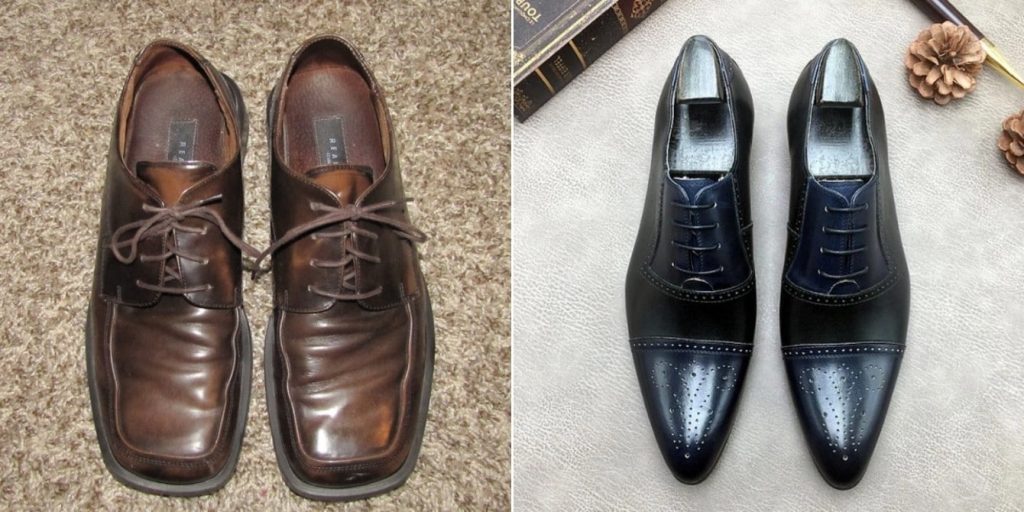Russian leather shoes are known for their unique scent, rich colors, and softness. The hides are treated using a secret balance of natural oils, which preserves the leather’s strength, flexibility and durability.
Russians prefer shoes of high-quality which can be able to withstand the local climate, while Europeans prefer bright, drab winter shoes.
Craftsmanship
The simplest shoes were constructed of heavy, thick cowhide leather with no embellishments. The leather used to make these shoes was more flexible and thinner. These were the shoes worn by artisans and peasants. The leather that was thick on the soles was attached to the upper and heel quarters using a variety of methods, including an inner seam, and sewing with a needle (Illustration 4, items 2v-4). The liner [Rus. The podnariad or podnarjad is sewn on the upper and heel with a special stitch.
The archeological evidence also shows that shoemakers in medieval Novgorod employed a variety of methods for embellishing their shoes, including stamping, embroidery, and leather carving. They also carved their name on the leather or at the bottom of the shoe.
Openwork boots first appeared in the 14th century. They were similar to soft shoes, in that they featured one forward cut, and standing or lightly bent sides. Rawhide laces were used to tie the boots to the inside of the instep.
Schuh-Bertl has found a way to make use of this leather despite its rarity. They use it to make their Russia leather boots, which are now menswear legend because they’re incredibly durable and almost indestructible.
Durability
In addition to being beautiful, Russian giay da the thao nam are also extremely durable. This is because of their unique tanning process which results in stronger and more supple leather. They are also extremely repellent to insects and water. They are great for outdoor sports and long walks. In fact, the quality of these footwear is so great that they are frequently used by professional hunters and hikers.
One of the most famous instances of Russian leather was discovered in the wreckage of Metta Catharina. When divers found bundles of Russian reindeer hides, they instantly became a historical legend. The skins had a claret-colored color with a distinctive aroma. After the divers had cleaned the hides, they were contacted by custom shoemakers from Cleverly. Cleverly’s shoemakers believed that they could do justice to the famous leather.
Leather was tanned by using oak bark and then oiled with the tar of birch to impart the hardwearing and waterproof properties that made it famous. The popularity of the leather spread across the world until Russian Revolution, when the recipe and tanning techniques were lost.
Hermes has recreated the look and feel with a process known as “Russian calf”. First, the finest calfskins are carefully selected (only those that are younger than one year old, and not older than six months old for the typical calveskin). Then, they’re soaked in a tanning pit that is made out of willow, oak and birch bark, all endemic trees from the region where the leather was crafted. Finally, they are dyed and printed with the characteristic cross-hatch pattern found in Russian leather.

Quality Control
Many shoemakers are still using their old methods but have started to adopt the latest technologies. The Yachting factory, for example has replaced foreign-made manufacturing blanks and manufactures shoes from beginning to the end in Russia. This allows for more flexibility to adapt to the requirements of clients, and reduces production times. This also improves the quality of the footwear by eliminating imperfections.
Manufacturing processes and materials are important factors in determining the quality of the footwear. The shoemakers should use only the finest materials, and their factories must be clean and well-equipped. To ensure the high-quality of their goods, businesses must also follow a rigorous inspection plan. A good inspector will know what tests to run and will assist you in achieving the highest possible standards of quality.
In order to sell in Russia footwear must meet certain standards, which includes the testing of harmful chemicals. Hohenstein will examine your leather footwear for harmful chemicals in line to the LEATHERSTANDARD RSL and will issue a certificate.
The quality of Russian shoes is an important factor in the country’s economy. Good quality shoes are a fantastic option to get customers’ attention and help boost the economy of a country. In spite of the difficulties that the Russian shoe industry is positive. For instance, the Egorievsk Shoemaker Company continues to invest in the city and supports the restoration of historical monuments. It also provides sponsorship for children’s sports and assists war and labor veterans.
Manufacturing processes
The standards for Russian leather shoe production are extremely rigorous, since the shoes must be in compliance with GOST and the advanced Roskachestvo standard. These standards include more stringent requirements for tailoring as well as the toxicity. They have to pass a compulsory test to ensure they meet environmental standards. They are made of local materials.
The shoemaker also has to adhere to an array of guidelines and specifications to guide the manufacturing and design process. The soles, for instance are required to be waterproof and long-lasting. The uppers should also be flexible to allow for flexibility in all directions and support the natural shape of your foot. The process of making the footwear is built on a full cycle, from cutting the skin until the packaging of the final product.
Furthermore, the footwear must be soft and comfortable. Additionally, they should resist abrasion as well as corrosion. This is the reason that many Russian producers make footwear that has textile uppers. In 2022, the production of shoes surpassed 34 million pairs.
According to Trap Aggressor (a Ukrainian project for monitoring sanctions), Russian military shoemakers import raw material as well as equipment from Europe. Directly imported products valued at 4.1 million dollars from European companies include glue, leather and parts for shoe-making equipment. Inna Khramtsova, the leading designer for the company Unichel, has been creating shoes for more than 20 years. She knows what shoes Russian women are buying in the present and which ones will be popular in the near future.
